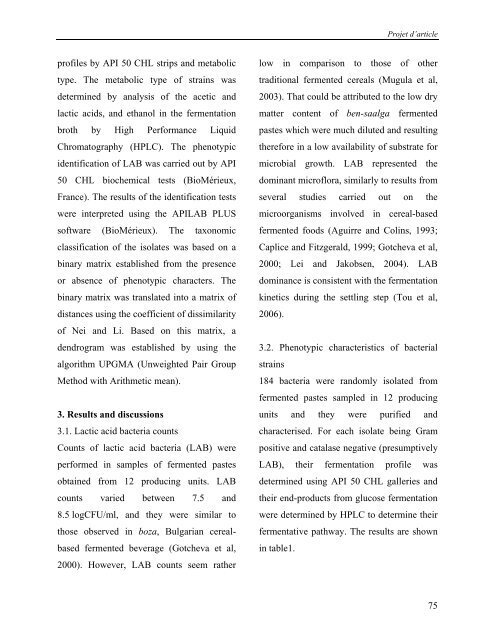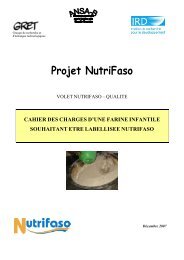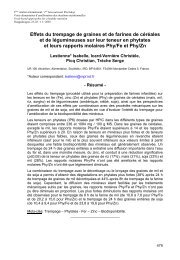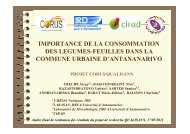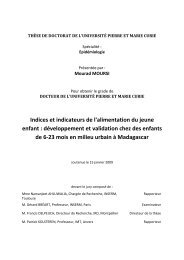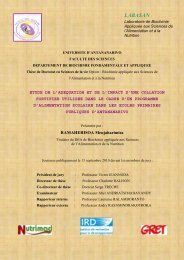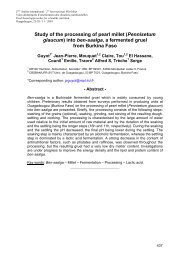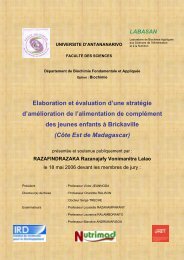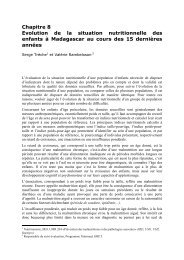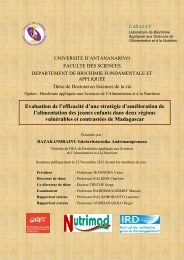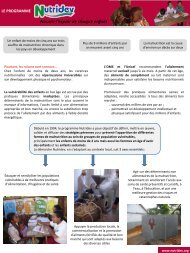THESE UNIQUE El Hassane Kéhien-Piho TOU - Nutridev
THESE UNIQUE El Hassane Kéhien-Piho TOU - Nutridev
THESE UNIQUE El Hassane Kéhien-Piho TOU - Nutridev
Create successful ePaper yourself
Turn your PDF publications into a flip-book with our unique Google optimized e-Paper software.
Projet d’article<br />
profiles by API 50 CHL strips and metabolic<br />
type. The metabolic type of strains was<br />
determined by analysis of the acetic and<br />
lactic acids, and ethanol in the fermentation<br />
broth by High Performance Liquid<br />
Chromatography (HPLC). The phenotypic<br />
identification of LAB was carried out by API<br />
50 CHL biochemical tests (BioMérieux,<br />
France). The results of the identification tests<br />
were interpreted using the APILAB PLUS<br />
software (BioMérieux). The taxonomic<br />
classification of the isolates was based on a<br />
binary matrix established from the presence<br />
or absence of phenotypic characters. The<br />
binary matrix was translated into a matrix of<br />
distances using the coefficient of dissimilarity<br />
of Nei and Li. Based on this matrix, a<br />
dendrogram was established by using the<br />
algorithm UPGMA (Unweighted Pair Group<br />
Method with Arithmetic mean).<br />
3. Results and discussions<br />
3.1. Lactic acid bacteria counts<br />
Counts of lactic acid bacteria (LAB) were<br />
performed in samples of fermented pastes<br />
obtained from 12 producing units. LAB<br />
counts varied between 7.5 and<br />
8.5 logCFU/ml, and they were similar to<br />
those observed in boza, Bulgarian cerealbased<br />
fermented beverage (Gotcheva et al,<br />
2000). However, LAB counts seem rather<br />
low in comparison to those of other<br />
traditional fermented cereals (Mugula et al,<br />
2003). That could be attributed to the low dry<br />
matter content of ben-saalga fermented<br />
pastes which were much diluted and resulting<br />
therefore in a low availability of substrate for<br />
microbial growth. LAB represented the<br />
dominant microflora, similarly to results from<br />
several studies carried out on the<br />
microorganisms involved in cereal-based<br />
fermented foods (Aguirre and Colins, 1993;<br />
Caplice and Fitzgerald, 1999; Gotcheva et al,<br />
2000; Lei and Jakobsen, 2004). LAB<br />
dominance is consistent with the fermentation<br />
kinetics during the settling step (Tou et al,<br />
2006).<br />
3.2. Phenotypic characteristics of bacterial<br />
strains<br />
184 bacteria were randomly isolated from<br />
fermented pastes sampled in 12 producing<br />
units and they were purified and<br />
characterised. For each isolate being Gram<br />
positive and catalase negative (presumptively<br />
LAB), their fermentation profile was<br />
determined using API 50 CHL galleries and<br />
their end-products from glucose fermentation<br />
were determined by HPLC to determine their<br />
fermentative pathway. The results are shown<br />
in table1.<br />
75


